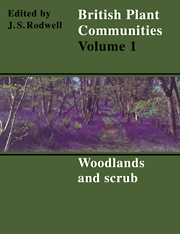Book contents
- Frontmatter
- Contents
- List of Figures
- Foreword
- Preface and Acknowledgements
- Preamble
- General Introduction
- Woodlands and Scrub
- Introduction to Woodlands and Scrub
- Key To Woodlands and Scrub
- Community Descriptions
- W1 Salix Cinerea-Galium Palustre woodland
- W2 Salix Cinerea-Betula Pubescens-Phragmites Australis Woodland
- W3 Salix Pentandra-Carex Rostrata Woodland
- W4 Betula Pubescens-Molinia Caerulea Woodland
- W5 Alnus Glutinosa-Carex Paniculata Woodland
- W6 Alnus Glutinosa-Urtica Jzozca Woodland
- W7 Ainus Glutinosa-Fraxinus Excelsior-Lysimachia Nemorum Woodland
- W8 Fraxinus Excelsior-Acer Campestre-Mercurialis Perennis Woodland
- W9 Fraxinus Excelsior-Sorbus Aucuparia-Mercurialis Perennis Woodland
- W10 Quereus Robur-Pteridium Aquilinum-Rubus Fruticosus Woodland
- W11 Quereus Petraea-Betula Pubescens-Oxalis Acetosella Woodland
- W12 Fagus Sylvatica-Mercurialis Perennis Woodland
- W13 Taxus Baccata Woodland
- W14 Fagus Sylvatica-Rubus Fruticosus Woodland
- W15 Fagus Sylvatica-Deschampsia Flexuosa Woodland
- W16 Quereus spp.-Betula spp.-Deschampsia Flexuosa Woodland
- W17 Quereus Petraea-Betula Pubescens-Dicranum Majus Woodland
- W18 Pinus Sylvestris-Hylocomium Splendens Woodland
- W19 Juniperus Communis Ssp. Communis-Oxalis Acetosella Woodland
- W20 Salix Lapponum-Luzula Sylvatica Scrub
- W21 Crataegus monogyna-Hedera helix scrub
- W22 Prunus Spinosa-Rubus Fruticosus Scrub
- W23 Ulex Europaeus-Rubus Fruticosus Scrub
- W24 Rubus Fruticosus-Holcus Lanatus Underscrub
- W25 Pteridium Aquilinum-Rubus Fruticosus Underscrub
- Index of Synonyms to Woodlands and Scrub
- Index of Species in Woodlands and Scrub
- Bibliography
W13 - Taxus Baccata Woodland
Published online by Cambridge University Press: 04 July 2020
- Frontmatter
- Contents
- List of Figures
- Foreword
- Preface and Acknowledgements
- Preamble
- General Introduction
- Woodlands and Scrub
- Introduction to Woodlands and Scrub
- Key To Woodlands and Scrub
- Community Descriptions
- W1 Salix Cinerea-Galium Palustre woodland
- W2 Salix Cinerea-Betula Pubescens-Phragmites Australis Woodland
- W3 Salix Pentandra-Carex Rostrata Woodland
- W4 Betula Pubescens-Molinia Caerulea Woodland
- W5 Alnus Glutinosa-Carex Paniculata Woodland
- W6 Alnus Glutinosa-Urtica Jzozca Woodland
- W7 Ainus Glutinosa-Fraxinus Excelsior-Lysimachia Nemorum Woodland
- W8 Fraxinus Excelsior-Acer Campestre-Mercurialis Perennis Woodland
- W9 Fraxinus Excelsior-Sorbus Aucuparia-Mercurialis Perennis Woodland
- W10 Quereus Robur-Pteridium Aquilinum-Rubus Fruticosus Woodland
- W11 Quereus Petraea-Betula Pubescens-Oxalis Acetosella Woodland
- W12 Fagus Sylvatica-Mercurialis Perennis Woodland
- W13 Taxus Baccata Woodland
- W14 Fagus Sylvatica-Rubus Fruticosus Woodland
- W15 Fagus Sylvatica-Deschampsia Flexuosa Woodland
- W16 Quereus spp.-Betula spp.-Deschampsia Flexuosa Woodland
- W17 Quereus Petraea-Betula Pubescens-Dicranum Majus Woodland
- W18 Pinus Sylvestris-Hylocomium Splendens Woodland
- W19 Juniperus Communis Ssp. Communis-Oxalis Acetosella Woodland
- W20 Salix Lapponum-Luzula Sylvatica Scrub
- W21 Crataegus monogyna-Hedera helix scrub
- W22 Prunus Spinosa-Rubus Fruticosus Scrub
- W23 Ulex Europaeus-Rubus Fruticosus Scrub
- W24 Rubus Fruticosus-Holcus Lanatus Underscrub
- W25 Pteridium Aquilinum-Rubus Fruticosus Underscrub
- Index of Synonyms to Woodlands and Scrub
- Index of Species in Woodlands and Scrub
- Bibliography
Summary
Synonymy
Yew-woods Tansley & Rankin 1911, Watt 1926, Tansley 1939, Ratcliffe 1977.
Constant species
Taxus baccata.
Rare species
Buxus sempervirens.
Physiognomy
Only rarely can such species-poor vegetation as mature Taxus baccata woodland present such a memorable spectacle. Taxus is the only constant woody species here, indeed the only constant, being an uncompromising dominant in a canopy that is rarely higher than 10 m but typically closed and very dense. Beyond the outer margins of stands, which can be wind-pruned and surrounded by a fringe of shrubs and clitnbers of the neighbouring scrub, Taxus reigns supreme in sometimes quite extensive stretches of striking floristic poverty and uniformity. In such a scene, the different character of the individual trees is very impressive, with pioneers of venerable appearance, richly branched from the ground and often with their trunks fused into weird shapes, and, between them, younger trees, less branched but frequently grown up lop-sided in the shade of the earlier invaders (Watt 1926, Williamson 1978).
No other tree is more than occasional throughout the community, though Sorbus aria is a very characteristic associate and, in one sub-community, it becomes a little more frequent, its crowns characteristically taller than the Taxus canopy and, with their dusty white foliage, forming a sharp contrast to the sea of dark green around. Quite commonly, it carries Viscum album. Emergent Fraxinus excelsior can also sometimes be seen and, rarely, there can be widely-scattered Fagus sylvatica, Acer pseudoplatanus or Quercus robur.
The picture beneath the Taxus is characteristically gloomy and bare. In the first place, there is no true understorey here. Associated shrubs are rare, except around the margins of stands and in gaps, and usually there is nothing more than a few sparse and spindly specimens of Sambucus nigra and a very occasional drawn-up Ilex aquifolium or Crataegus monogyna. Although seedlings of Taxus appear in large numbers in most years, they disappear by autumn and saplings occur only rarely. Where the canopy is a little thinner there may be some young Fraxinus or A. pseudoplatanus. In a few stands, Buxus sempervirens is a distinctive associate, and it can grow up as a very local canopy dominant.
- Type
- Chapter
- Information
- British Plant Communities , pp. 234 - 240Publisher: Cambridge University PressPrint publication year: 1991

